
Halpe homolea, the Indian ace or Ceylon ace, is a butterfly belonging to the family Hesperiidae.
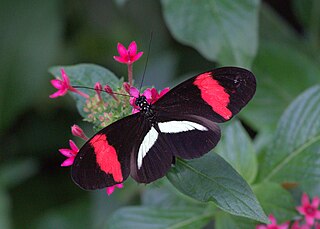
Heliconius erato, or the red postman, is one of about 40 neotropical species of butterfly belonging to the genus Heliconius. It is also commonly known as the small postman, the red passion flower butterfly, or the crimson-patched longwing. It was described by Carl Linnaeus in his 1758 10th edition of Systema Naturae.

Heliconius cydno, the cydno longwing, is a nymphalid butterfly that ranges from Mexico to northern South America. It is typically found in the forest understory and deposits its eggs on a variety of plants of the genus Passiflora. It is a member of the Heliconiinae subfamily of Central and South America, and it is the only heliconiine that can be considered oligophagous. H. cydno is also characterized by hybridization and Müllerian mimicry. Wing coloration plays a key role in mate choice and has further implications in regards to sympatric speciation. Macrolide scent gland extracts and wing-clicking behavior further characterize this species.

Heliconius comprises a colorful and widespread genus of brush-footed butterflies commonly known as the longwings or heliconians. This genus is distributed throughout the tropical and subtropical regions of the New World, from South America as far north as the southern United States. The larvae of these butterflies eat passion flower vines (Passifloraceae). Adults exhibit bright wing color patterns which signal their distastefulness to potential predators.

Papilio zalmoxis, the giant blue swallowtail, is an African butterfly belonging to the family Papilionidae. The name of the species is given in honor of Zalmoxis – a divinity of the Getae, mentioned by Herodotus in his Histories IV, 93–96.
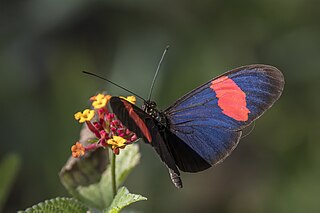
Heliconius melpomene, the postman butterfly, common postman or simply postman, is a brightly colored, geographically variable butterfly species found throughout Central and South America. It was first described by Carl Linnaeus in his 1758 10th edition of Systema Naturae. Its coloration coevolved with another member of the genus, H. erato as a warning to predators of its inedibility; this is an example of Müllerian mimicry. H. melpomene was one of the first butterfly species observed to forage for pollen, a behavior that is common in other insect groups but rare in butterflies. Because of the recent rapid evolutionary radiation of the genus Heliconius and overlapping of its habitat with other related species, H. melpomene has been the subject of extensive study on speciation and hybridization. These hybrids tend to have low fitness as they look different from the original species and no longer exhibit Müllerian mimicry.

Papilio antonio is a butterfly of the family Papilionidae. It is endemic to the Philippines.
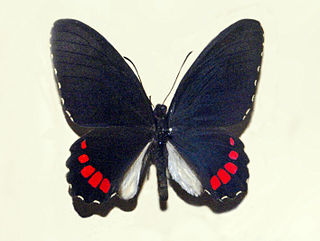
Parides erithalion, the variable cattleheart, is a North and South American butterfly in the family Papilionidae. The species was first described by Jean Baptiste Boisduval in 1836.

Papilio zagreus is a butterfly of the family Papilionidae (swallowtails). It is found in South America, including Venezuela, Colombia, Ecuador, Peru, Bolivia and western Brazil.

Heliconius hecalesia, the five-spotted longwing, is a species of butterfly of the family Nymphalidae. It is found from Central America to Venezuela and Ecuador.

Heliconius numata, the Numata longwing, is a brush-footed butterfly species belonging to the family Nymphalidae, subfamily Heliconiinae.

Tithorea tarricina, the tarricina longwing, variable presonian, or cream-spotted tigerwing, is a species of butterfly belonging to the family Nymphalidae.

Eurytides agesilaus, the short-lined kite swallowtail, is a medium-sized species of butterfly in the family Papilionidae.
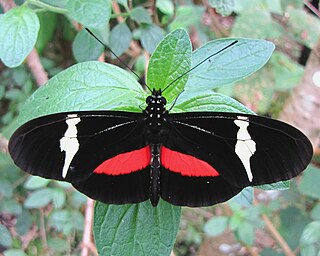
Heliconius clysonymus, the Clysonymus longwing, yellow longwing or montane longwing, is a species of Heliconius butterfly found in Central and South America.

Hyantis is a monotypic nymphalid butterfly genus. Its sole species is Hyantis hodeva, which is found in New Guinea. It is uncertain which tribe this butterfly should be placed within.
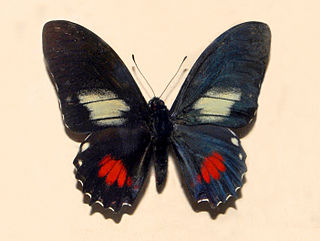
Mimoides euryleon, the false cattleheart swallowtail, is a species of butterfly in the family Papilionidae.

Mimoides pausanias, the Pausanias swallowtail or bluish mimic-swallowtail, is a species of butterfly in the family Papilionidae.

Ithomeis is a genus in the butterfly family Riodinidae present only in the Neotropical realm.

Heliconius sapho, the Sapho longwing, is a butterfly of the family Nymphalidae. It was described by Dru Drury in 1782. It is found from Mexico southward to Ecuador.
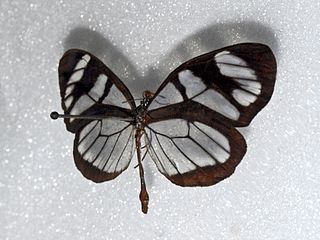
Oleria flora is a species of butterfly of the family Nymphalidae.













